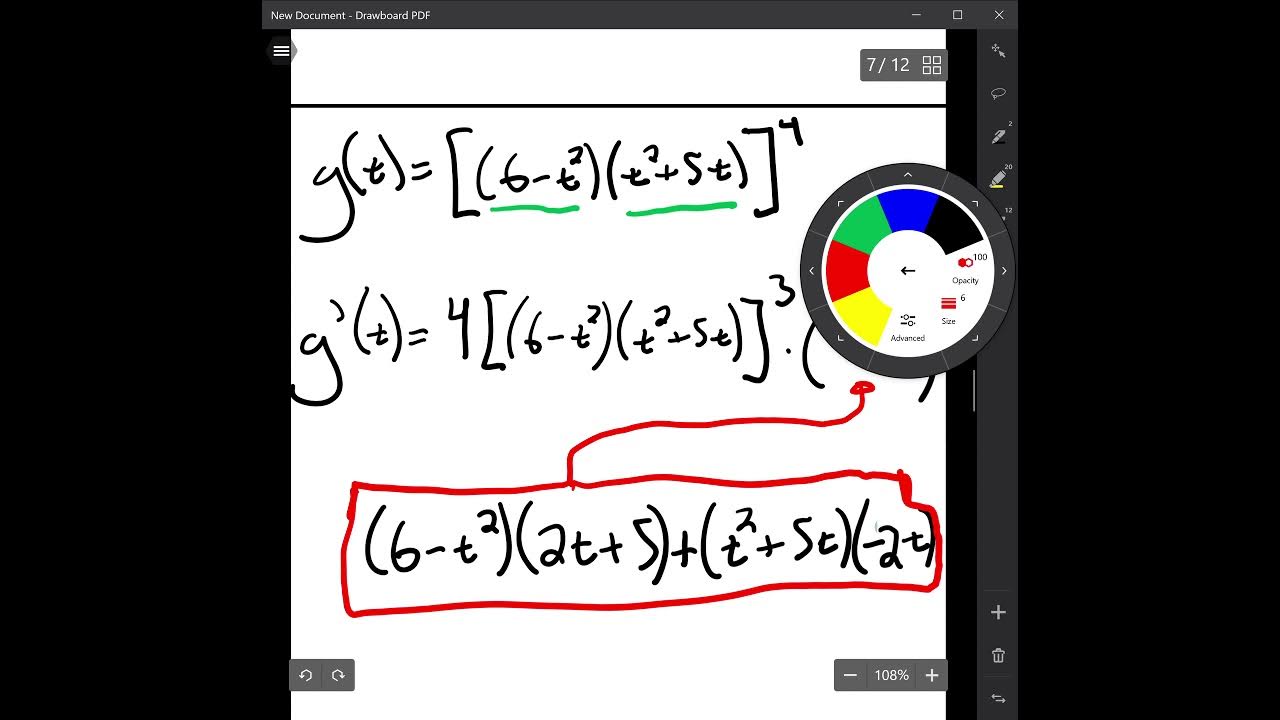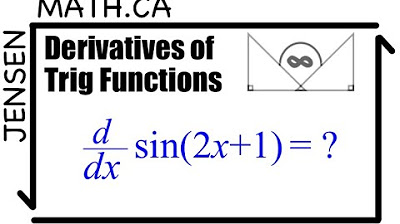Manipulating functions before differentiation | Derivative rules | AP Calculus AB | Khan Academy
TLDRThe video script discusses various derivative rules such as the power rule, product rule, quotient rule, and chain rule, emphasizing the importance of recognizing when to apply each for efficient problem-solving. It illustrates through examples how algebraic simplification can streamline the process of differentiation, making complex problems easier to tackle. The instructor encourages viewers to consider different approaches before applying the quotient rule, highlighting the potential for simpler solutions.
Takeaways
- 📝 Familiarity with derivative rules is crucial before proceeding with this lesson.
- 🤔 The video focuses on strategic application of derivative rules and simplifying expressions algebraically.
- 🔍 Review of the power rule, product rule, quotient rule, and chain rule is provided for clarity.
- 🌟 Importance of recognizing when to apply each derivative rule is emphasized.
- 📈 Example: Derivative of X^2 + X - 2/(X-1) can be simplified by factoring the numerator.
- 🤹♂️ Strategy: Simplify the expression algebraically before applying derivative rules to reduce complexity.
- 📚 Practice is suggested for solidifying understanding of the power rule, product rule, and quotient rule.
- 🔄 Transforming expressions, such as X^2 + 2X - 5/X, can lead to easier derivative calculations.
- 📝 Example: Derivative of √X/X^2 can be simplified by combining terms and using exponent properties.
- ⏸️ Pausing to consider algebraic or trigonometric simplifications before applying complex rules is advised.
- 📊 Multiple approaches to derivative problems are highlighted, showcasing the flexibility in problem-solving.
Q & A
What is the main focus of the video?
-The main focus of the video is to discuss strategies for applying derivative rules effectively and to recognize when algebraic simplification can make the process easier.
What is the power rule mentioned in the video?
-The power rule is a fundamental derivative rule that states the derivative of x raised to a power is that power times x raised to the power minus one.
How can the power rule be used with other derivative properties?
-The power rule can be used with properties such as sum and difference of derivatives to find the derivatives of polynomials.
What is the product rule and when is it applied?
-The product rule is applied when taking the derivative of a product of two functions. It states that the derivative of the product is the derivative of the first function times the second function plus the first function times the derivative of the second function.
What is the quotient rule and how can it be simplified?
-The quotient rule is used for taking the derivative of a quotient of two functions. It can often be simplified by expressing the quotient as a product and then applying a combination of the product and chain rules.
What is the chain rule and when might it be necessary to use it?
-The chain rule is used when the derivative of a composite function is needed. It involves taking the derivative of the outer function with respect to the inner function and then multiplying by the derivative of the inner function.
How can factoring the numerator simplify the derivative of an expression?
-Factoring the numerator can simplify the derivative process by allowing for cancellation of terms or by reducing the complexity of the expression, making it easier to apply a simpler derivative rule like the power rule.
What is the strategy recommended for dealing with complex derivative problems?
-The recommended strategy is to pause and look for an algebraic or trigonometric simplification before applying complex rules like the quotient or product rule. This can often make the problem easier to solve.
How does the video demonstrate the simplification of the expression (x^2 + x - 2) / (x - 1)?
-The video demonstrates that by factoring the numerator as (x + 2)(x - 1), the expression can be simplified to the derivative of (x + 2) with respect to x, which is a much simpler process using the power rule.
What is an example of a problem where the quotient rule might be tempting to use, but a better simplification is possible?
-An example is the expression (x^2 + 2x - 5) / x. Instead of using the quotient rule, the numerator can be divided by x, simplifying the expression to x^-1 + 2x^-1 - 5x^-2, making the derivative easier to find using the power rule.
How does the video illustrate the concept of simplifying before applying derivative rules?
-The video illustrates this concept through multiple examples, showing how algebraic manipulations or simplifications can reduce the complexity of the expressions, making it easier to apply simpler derivative rules like the power rule instead of the more complex quotient or product rules.
Outlines
📚 Introduction to Derivative Rules and Strategies
This paragraph introduces various derivative rules that have been covered in previous videos and emphasizes the importance of understanding these rules before proceeding. The instructor encourages viewers to review the power rule, product rule, quotient rule, and chain rule if they are not familiar with them. The main focus of this section is to discuss strategies for deciding when to apply which rule and how to algebraically convert expressions to use simpler rules. The instructor presents an expression (X squared plus X minus two over X minus one) and discusses different approaches to finding its derivative, highlighting the benefits of algebraic simplification before applying derivative rules.
🧠 Algebraic Simplification Before Applying Derivative Rules
In this paragraph, the instructor continues the discussion on the importance of algebraic simplification before applying derivative rules. Using two examples, the video script illustrates how simplifying the algebraic expression can make the process of differentiation easier and less complicated. The first example involves the expression (X squared plus two X minus five over X), where the instructor shows how to simplify it by dividing each term by X. The second example deals with the expression (square root of X over X squared), where the instructor demonstrates a better simplification by using exponent properties. The key message is to always look for ways to simplify expressions before applying more complex derivative rules like the quotient or product rule.
🤔 Evaluating Different Approaches to Derivatives
This paragraph further explores different approaches to finding derivatives and encourages pausing to evaluate the most efficient method before applying the quotient rule. The instructor provides an example of the expression (one over 2x minus five) and explains how to apply the quotient rule, chain rule, and power rule in combination. Another example given is the derivative of (2x plus one squared), where the instructor presents two different methods: one using the chain rule and the other by expanding and applying the power rule. The main takeaway is to always consider multiple ways to approach derivatives and to prefer methods that avoid the complexity of the quotient rule when possible.
Mindmap
Keywords
💡Derivative
💡Power Rule
💡Product Rule
💡Quotient Rule
💡Chain Rule
💡Algebraic Simplification
💡Strategies
💡Polynomials
💡Rational Expressions
💡Factoring
💡Exponents
Highlights
The video discusses the application of derivative rules and strategies for their effective use.
Power rule is introduced as a fundamental tool for taking derivatives of functions involving x raised to a power.
Derivative properties of sums or differences are used for polynomial differentiation.
Product rule is explained for taking derivatives of expressions that are products of two functions.
Quotient rule is discussed, which can be complex but can be simplified by converting quotients to products.
Chain rule is introduced for dealing with composite functions and their derivatives.
The video emphasizes the importance of recognizing when to apply which derivative rule for efficiency.
An example is provided where factoring the numerator simplifies the derivative process using power rule instead of quotient rule.
Algebraic manipulation is suggested as a means to simplify expressions before applying derivative rules.
A second example demonstrates the advantage of viewing expressions as products to apply the product rule more easily.
The video illustrates how dividing terms by x can simplify the process of taking derivatives.
An example with a complex expression is solved by using exponent properties to simplify the derivative process.
The video suggests pausing before applying the quotient rule to check if there's an easier algebraic approach.
A derivative example is presented where the quotient rule is applied using the chain rule for a composite function.
The video encourages exploring multiple methods for derivative problems, as there is not always a single correct approach.
A final example shows how expanding expressions can lead to a straightforward application of the power rule.
The video concludes with the advice to always look for simplifications before applying derivative rules, particularly the quotient rule.
Transcripts
Browse More Related Video

Derivatives with Multiple Rules

How to take Derivatives in Calculus - Differentiation Formulas - [1-3]

Product rule | Taking derivatives | Differential Calculus | Khan Academy

Derivatives of Trig Functions - Calculus | MCV4U

Applying the chain rule and product rule | Advanced derivatives | AP Calculus AB | Khan Academy

The Chain Rule - Part 2
5.0 / 5 (0 votes)
Thanks for rating: